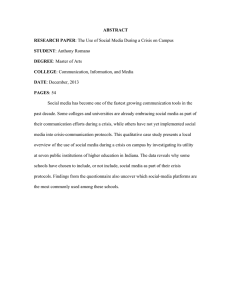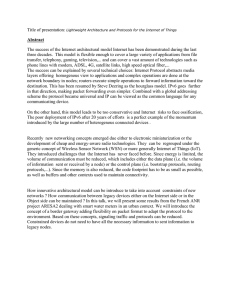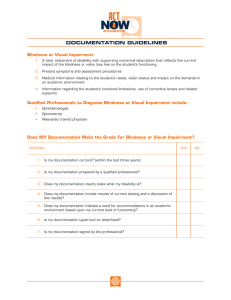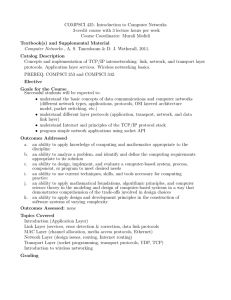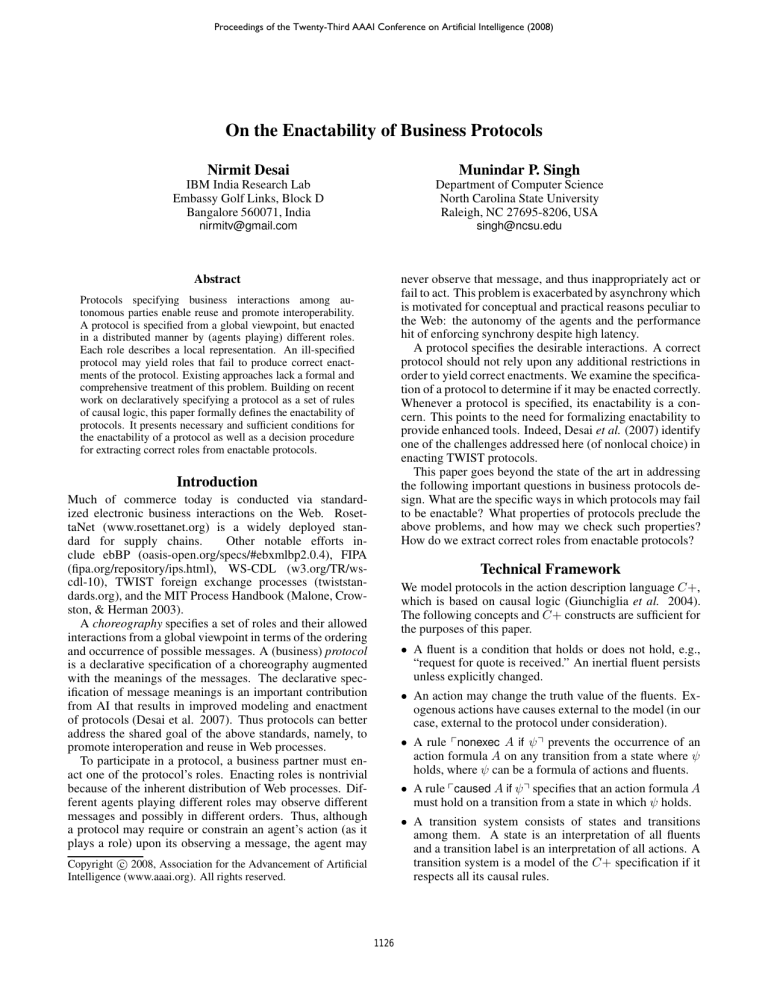
Proceedings of the Twenty-Third AAAI Conference on Artificial Intelligence (2008)
On the Enactability of Business Protocols
Nirmit Desai
Munindar P. Singh
IBM India Research Lab
Embassy Golf Links, Block D
Bangalore 560071, India
Department of Computer Science
North Carolina State University
Raleigh, NC 27695-8206, USA
nirmitv@gmail.com
singh@ncsu.edu
Abstract
never observe that message, and thus inappropriately act or
fail to act. This problem is exacerbated by asynchrony which
is motivated for conceptual and practical reasons peculiar to
the Web: the autonomy of the agents and the performance
hit of enforcing synchrony despite high latency.
A protocol specifies the desirable interactions. A correct
protocol should not rely upon any additional restrictions in
order to yield correct enactments. We examine the specification of a protocol to determine if it may be enacted correctly.
Whenever a protocol is specified, its enactability is a concern. This points to the need for formalizing enactability to
provide enhanced tools. Indeed, Desai et al. (2007) identify
one of the challenges addressed here (of nonlocal choice) in
enacting TWIST protocols.
This paper goes beyond the state of the art in addressing
the following important questions in business protocols design. What are the specific ways in which protocols may fail
to be enactable? What properties of protocols preclude the
above problems, and how may we check such properties?
How do we extract correct roles from enactable protocols?
Protocols specifying business interactions among autonomous parties enable reuse and promote interoperability.
A protocol is specified from a global viewpoint, but enacted
in a distributed manner by (agents playing) different roles.
Each role describes a local representation. An ill-specified
protocol may yield roles that fail to produce correct enactments of the protocol. Existing approaches lack a formal and
comprehensive treatment of this problem. Building on recent
work on declaratively specifying a protocol as a set of rules
of causal logic, this paper formally defines the enactability of
protocols. It presents necessary and sufficient conditions for
the enactability of a protocol as well as a decision procedure
for extracting correct roles from enactable protocols.
Introduction
Much of commerce today is conducted via standardized electronic business interactions on the Web. RosettaNet (www.rosettanet.org) is a widely deployed standard for supply chains.
Other notable efforts include ebBP (oasis-open.org/specs/#ebxmlbp2.0.4), FIPA
(fipa.org/repository/ips.html), WS-CDL (w3.org/TR/wscdl-10), TWIST foreign exchange processes (twiststandards.org), and the MIT Process Handbook (Malone, Crowston, & Herman 2003).
A choreography specifies a set of roles and their allowed
interactions from a global viewpoint in terms of the ordering
and occurrence of possible messages. A (business) protocol
is a declarative specification of a choreography augmented
with the meanings of the messages. The declarative specification of message meanings is an important contribution
from AI that results in improved modeling and enactment
of protocols (Desai et al. 2007). Thus protocols can better
address the shared goal of the above standards, namely, to
promote interoperation and reuse in Web processes.
To participate in a protocol, a business partner must enact one of the protocol’s roles. Enacting roles is nontrivial
because of the inherent distribution of Web processes. Different agents playing different roles may observe different
messages and possibly in different orders. Thus, although
a protocol may require or constrain an agent’s action (as it
plays a role) upon its observing a message, the agent may
Technical Framework
We model protocols in the action description language C+,
which is based on causal logic (Giunchiglia et al. 2004).
The following concepts and C+ constructs are sufficient for
the purposes of this paper.
• A fluent is a condition that holds or does not hold, e.g.,
“request for quote is received.” An inertial fluent persists
unless explicitly changed.
• An action may change the truth value of the fluents. Exogenous actions have causes external to the model (in our
case, external to the protocol under consideration).
• A rule pnonexec A if ψq prevents the occurrence of an
action formula A on any transition from a state where ψ
holds, where ψ can be a formula of actions and fluents.
• A rule pcaused A if ψq specifies that an action formula A
must hold on a transition from a state in which ψ holds.
• A transition system consists of states and transitions
among them. A state is an interpretation of all fluents
and a transition label is an interpretation of all actions. A
transition system is a model of the C+ specification if it
respects all its causal rules.
Copyright c 2008, Association for the Advancement of Artificial
Intelligence (www.aaai.org). All rights reserved.
1126
A protocol and a role each are given by C+ specifications whose rules specify the meanings of and constraints on
the messages to be exchanged. A protocol exhibits a global
viewpoint in that its rules talk about message exchanges (as
if send and receive were a single atomic event). A role, on
the other hand, exhibits a local viewpoint in that its rules
treat sending and receiving a message as separate actions,
and treat the communication channels explicitly.
Let us first consider protocols. A message m from role α
to role β is written m(α, β). For each message mi , we define an exogenous action symbol mi A to denote the action of
exchanging mi , and an inertial fluent symbol mi F to record
the fact that mi is exchanged. Modeling the messages as exogenous actions reflects the autonomy of the agents playing
a role: a protocol doesn’t “explain”—in the sense of causal
logic—why agents act the way they do.
The business meaning of a message is given in terms
of commitments. A commitment C(x, y, p, q) means that
debtor x is committed to creditor y to do consequent q if
antecedent p is done. Unlike obligations, commitments are
directed, contextual, and manipulable (Singh 1999). For example, a message may create , delegate , assign , or cancel
a commitment. A message may also cause antecedent or
a consequent of a commitment, thereby detaching or discharging it, respectively. For example, if p is caused, the
above commitment is detached and becomes unconditional:
C(x, y, T, q). If q is caused the commitment is discharged.
Our protocol specification language includes the following schemas. Commitments are inertial fluents and commitment antecedents, consequents, and operations are actions.
S CHEMA1 .
S CHEMA2 .
S CHEMA3 .
S CHEMA4 .
payment, the seller would deliver the goods. O RD2 specifies the meaning of accept. O RD3 specifies that accept
and reject are mutually exclusive. Each of the remaining
rules make a message nonrepeatable by making it nonexecutable when its corresponding fluent holds. O RD4 has no
other purpose. O RD5 prevents quote if reqForQuote has not
happened. O RD6 prevents accept if quote has not yet happened or reject has already happened. O RD7 prevents reject
similarly.
Infrastructure Assumptions. We assume that the messaging infrastructure is reliable (no messages lost, duplicated, or spuriously sent), point-to-point, asynchronous, and
supports an unbounded random access inbox for each role.
As in email or groupware settings, an agent playing a role
may choose what messages to read and may read them out of
order; reading a message removes it from the inbox. Challenges similar to those addressed in this paper would arise
with FIFO channels, and can be addressed similarly.
Extracting Roles
Because progress depends on the agent’s private policies, it
cannot be guaranteed from the standpoint of protocols. In
general, even verifying if a set of agents will progress is
undecidable when they communicate via unbounded asynchronous channels (Bultan, Su, & Fu 2006). We emphasize
enactability, which simply means that any progress made by
agents playing roles is correct with respect to the protocol.
Since we consider only protocols and roles, below we use
the term role as shorthand for role or “any agent enacting a
role.”
Given a protocol, how can we extract the roles that would
correctly enact a protocol? The root of the problem is that, in
practical settings, message exchanges are asynchronous: the
sender doesn’t block for the receiver. Also, the messages are
point-to-point, implying only the sender and the receiver of
a message have knowledge of the message exchange. Even
in a two-party protocol, the roles may observe the messages
in different orders. Thus, in general, in protocols with three
or more roles, the roles would be unaware of the progress
being made by others.
nonexec m1 A ∧ m2 A
nonexec mA if ψf
caused a if ψ
caused mF if mA
ψf ::= ⊥ | > | mF | op | ¬ψf | ψf ∧ ψf | ψf ∨ ψf
ψ ::= mA | ⊥ | > | mF | op | ¬ψ | ψ ∧ ψ | ψ ∨ ψ
op ::= create | delegate | assign | cancel | release
a ::= op | antecedent | consequent
Note that ψf does not include message actions. Due to
S CHEMA3, the only actions that can be caused explicitly are
the commitment operations, antecedents, and consequents.
These actions manipulate the commitment fluents. In the
rest of the paper, ψ, ψ1 , and ψ2 are as ψ above and ψf is as
ψf above. S CHEMA4 is added automatically to the specification for each message in a protocol.
For example, an order placement protocol Ord between a
buyer and a seller may be specified as follows.
O RD1 .
O RD2 .
O RD3 .
O RD4 .
O RD5 .
O RD6 .
O RD7 .
caused create (C(S, B, pay, goods)) if quoteA
Figure 1: Typical conversations of protocols Ord and Rec
caused create (C(B, S, goods, pay)) if acceptA
nonexec acceptA ∧ rejectA
Definition 1 A conversation is a possible enactment of a
protocol. A protocol generates a conversation if the messages in the conversation occur on any path consistent with
a transition system that models the C+ specification of the
protocol. A set of roles generates a conversation if each
role sends and receives its respective messages in the conversation on any path consistent with a transition system that
nonexec reqForQuoteA if reqForQuoteF
nonexec quoteA if quoteF ∨ ¬reqForQuoteF
nonexec acceptA if acceptF ∨ ¬quoteF ∨ rejectF
nonexec rejectA if rejectF ∨ ¬quoteF ∨ acceptF
O RD1 specifies the meaning of quote as creating a commitment from the seller to the buyer that if the buyer makes a
1127
models the C+ specification of the role.
Observe that the reporter is not involved in, and hence not
aware of, the interactions involving the messages authOK
and authNOK. Thus, rule E RR1 incorrectly prohibits the receipt of the approved message. The receiver role (reporter
in this case) should not depend on the occurrence of messages in which it is not involved. A simple fix is to erase
references to messages not visible to the given role. Thus,
the correct specification for the reporter would be
Figure 1 shows sample conversations for Ord and the Rec
protocol introduced below. The above leads to the definition
of correctness of a set of roles.
Definition 2 A set of roles is correct with respect to a protocol iff the roles generate all and only the conversations
generated by the protocol.
R P 1 . nonexec ?approved if ¬|approved| ∨ approvedF
Extracting a role from a protocol amounts to choosing and
transforming a relevant subset of protocol rules to ensure
correct behavior for the selected role. The relevant rules are
those that apply to the messages that the role sends or receives and the commitments of which the role is either the
debtor or creditor. In general, the role may not be aware of
some of the fluents or actions in the premises of some of the
chosen rules. Such premises need to be adjusted.
Each role owns a knowledge base (KB) and an inbox.
Only a KB owner can read and write to it; only senders can
add, and only the owner (i.e., the addressee) can remove,
messages from an inbox.
Each message action mA(α, β) in a protocol, yields a
message sending action !m in role α and a message receiving action ?m in role β. An inertial fluent |m| denotes a
message in an inbox, logically in transit. A message action
mA(α, β) yields separate fluents mF for α and β, and a
fluent |m| in β’s inbox. Each protocol rule pcaused mF if
mA(α, β)q maps to rules for α and β as follows:
Sender:α
Receiver:β
caused mF if !m
caused |m| if !m
caused mF if ?m
caused ¬|m| if ?m
nonexec ?m if ¬|m|
Notice that R P1 does not refer to authOKF and authNOKF. The roles are still correct as the sender would send
the message only if it was allowed. However, the reporter
cannot locally verify whether the call center had received an
authorization from the provider when it sent an approval.
Problems of Enactability
Unfortunately, role extraction does not guarantee correctness in the sense of Definition 2: the roles extracted from a
protocol P need not generate conversations that P generates.
This problem cannot be fixed by improving role extraction
because it arises when the given protocol is ill-suited for enactment in a distributed setting. We define two classes of
problems: nonlocal choice and blindness. We show below
that a protocol yields correct roles iff it is not subject to nonlocal choice and blindness.
The first rules for each role record the occurrence of the
message. The second sender rule models the production of
the message in the inbox of the receiver whereas the second
receiver rule models the consumption of the message from
the receiver’s inbox. The third receiver rule stipulates that a
message must exist in its inbox for it to be received. These
rules show how reception causally depends on sending.
For example, a buyer (B) extracted from Ord :
B1 .
B2 .
B3 .
B4 .
B5 .
B6 .
B7 .
nonexec !reqForQuote if reqForQuoteF
nonexec ?quote if ¬reqForQuoteF ∨ quoteF
Figure 2: Scenarios: (a) nonlocal choice; (b)–(f) blindness
caused create (C(S, B, pay, goods)) if ?quote
nonexec !accept if ¬quoteF ∨ acceptF ∨ rejectF
Nonlocal Choice
nonexec !reject if ¬quoteF ∨ rejectF ∨ acceptF
Nonlocal choice is common in distributed settings (Ladkin & Leue 1995). To understand the problem of nonlocal
choice, consider a protocol NLC that specifies that messages
m1 (α, β) and m2 (β, α) cannot happen concurrently.
nonexec !accept ∧ !reject
caused create (C(B, S, goods, pay)) if !accept
In two-party protocols, all protocol rules are relevant to
each role. In the case of three or more parties, the above
naive approach fails. Ignoring other details, assume that the
claim receiving protocol Rec (Figure 1(r)) includes a rule
requiring that an approval be sent only after authOK:
NLC1 . nonexec m1 A ∧ m2 A
Roles (α and β) would be extracted as follows.
NLC-α1 . nonexec !m1 ∧ ?m2
NLC-β 1 . nonexec ?m1 ∧ !m2
However, these roles are incorrect for NLC. Because !m1
on α and !m2 on β are both enabled, their mutual exclusivity cannot be guaranteed, thus potentially violating NLC, as
Figure 2(a) shows.
R EC1 . nonexec approvedA if approvedF ∨ ¬authOKF
The naive approach yields the following for the reporter:
E RR1 . nonexec ?approved if ¬authOKF ∨ approvedF
1128
Blindness
Fatal Blindness Consider protocol FB with roles α, β,
and γ as in Figure 2(b), which are extracted as:
In protocols involving three or more roles, not all roles need
necessarily be sufficiently well-informed on the state of the
enactment. We call this the problem of blindness of roles
with respect to certain messages.
To understand blindness, consider a family of protocols
BL involving the same two messages. BL requires that neither m1 nor m2 be repeated and that m2 cannot happen before m1 . Each protocol in the BL family pairs the senders
and receivers of these messages differently.
FB-α1 . nonexec !m1 if m1 F
FB-β 1 . nonexec ?m1 if ¬|m1 | ∨ m1 F
FB-γ 1 . nonexec !m2 if m2 F
FB-δ 1 . nonexec ?m2 if ¬|m2 | ∨ m2 F
Here, no interpretation of the message exchange would
guarantee the correctness of the roles. This form of blindness is called fatal as it clearly represents an error in the
modeling of the original protocol.
The possibilities of Figure 2 assume that there are no other
rules in the protocol. Adding new rules may correct the
roles. For example, in FB, a new message m3 (β, γ) and
additional constraints such that m1 precedes m3 and m3
precedes m2 would preclude fatal and malignant blindness
by effectively enforcing an order between m1 and m2 . Our
method accounts for such additional rules.
BL1 . nonexec m1 A if m1 F
BL2 . nonexec m2 A if ¬m1 F ∨ m2 F
Benign Blindness Consider protocol BB with roles α, β,
and γ as in Figure 2(f), which are extracted as:
BB-α1 .
BB-β 1 .
BB-β 2 .
BB-γ 1 .
nonexec !m1 if m1 F
nonexec ?m1 if ¬|m1 | ∨ m1 F
nonexec !m2 if ¬m1 F ∨ m2 F
nonexec ?m2 if ¬|m2 | ∨ m2 F
Proposition 1 Figures 2(b)–(e) are the only problematic
protocols in the family BL.
Proof Sketch. BL specifies that message m1 precedes m2 .
There can only be five combinations of three distinct roles
being the sender and receiver of two messages m1 and m2
where m1 precedes m2 . We can verify by inspection that
Figures 2(b)–(f) show all of these. We showed above that
Figure 2(f) is not problematic and Figures 2(b)–(e) are problematic.
Note that γ is blind with respect to m1 and, as a result,
m1 F does not occur in BB-γ 1 . We can verify by inspection
that these roles are correct with respect to BB. However, γ
has no means to locally verify m1 , and thus to ensure that β
sent m2 only after receiving m1 . For instance, if the agent
playing β is faulty, it could send out m2 without receiving
m1 , thus violating BB. We call this form of blindness benign
as the roles are correct but not locally verifiable.
Malignant Blindness Consider protocol MB1 with roles
α, β, and γ as in Figure 2(c), which are extracted as:
MB1-α1 .
MB1-β 1 .
MB1-β 2 .
MB1-γ 1 .
Enactable Protocols
Given the above problematic possibilities in protocols, it is
essential to define a set of desirable properties that guarantee
enactability. Below P is a protocol.
nonexec !m1 if m1 F
nonexec ?m1 if ¬|m1 | ∨ m1 F
nonexec ?m2 if ¬|m2 | ∨ ¬m1 F ∨ m1 F
Definition 3 P is enactable if (1) the roles extracted from it
are guaranteed to be correct, (2) the role KBs are guaranteed
to agree on their commitments, and (3) there is at least one
conversation of P in which all commitments created within
the protocol are discharged.
nonexec !m2 if m2 F
Here, α and γ are blind with respect to m2 and m1 , respectively. Thus, there is a possibility that γ sends m2 before
α sends m1 . However, β would not receive m2 without receiving m1 . The correctness of these roles depends on how
a message order requirement in a protocol translates to the
requirements in roles. A protocol requirement that m1 must
happen before m2 can be interpreted in the roles as (SS) send
before send: !m1 before !m2 ; (SR) send before receive: !m1
before ?m2 ; (RS) receive before send: ?m1 before !m2 ; or
(RR) receive before receive: ?m1 before ?m2 . Although
RS is the safest interpretation—roles satisfying it satisfy the
other three—each of these interpretations is suitable in different applications. For example, in a purchasing scenario,
a shipper must have received a ship order from the merchant
before the shipper receives a status request from the customer (RR). MB1 roles are incorrect if SS or RS is adopted.
We call this form of blindness malignant as the correctness
of the roles depends on the translation of a global requirement to local requirements, which may be contextual. Likewise, MB2 (Figure 2(d)) is incorrect under SS, RS, or RR.
And, MB3 (Figure 2(e)) is incorrect under RS or RR. This
paper treats RS as the standard of correctness. In some applications, the remaining (more flexible) interpretations may
be acceptable.
Definition 4 Subscription. A role α is subscribed to
• A commitment operation op iff (1) if op is create , cancel ,
or release , then α is the debtor or the creditor of the commitment being manipulated, (2) if op is delegate , then α
is the delegator or the delegatee, and (3) if op is assign , α
is the assigner or the assignee.
• A commitment condition (consequent or antecedent)
cond of a commitment of which α is a debtor or a creditor.
Definition 5 A message mj proves an occurrence of a message mi if and only if P includes a rule of the form pnonexec
mj A if ¬mk F ∨ ψq, and either (1) mi =mk or (2) mk proves
an occurrence of mi .
Definition 6 Commitment awareness. A role α is aware of
• A commitment operation op iff P includes a rule of the
form pcaused op if ψq such that α is aware of ψ.
• A commitment condition cond iff P includes a rule of the
form pcaused cond if ψq such that ρi is aware of ψ.
Definition 7 Message awareness. A role α is
1129
• Directly aware of a message action mi A and fluent mi F
iff α is the sender or the receiver of mi .
• Indirectly aware of a message mi via a message mj iff
α is not directly aware of mi but is directly aware of mj
and mj proves mi .
• Aware of a message mi iff α is either directly aware of
mi or indirectly aware of mi via mj .
Hence, P satisfies P1. If fatal and malignant blindness do
not occur, then for each rule constraining message orders,
the sender of the message is either involved in the messages
in the premises of the rule, or it can prove the messages in
the premises of the rule. Hence, P satisfies P2. Also by definition, the agents playing roles agree on their commitments.
Thus, all agents playing roles are aware of the commitments
to which they are subscribed. Hence, P satisfies P3 and P4.
Similarly, for discharge of all the commitments created, P
must satisfy P5. Hence, P satisfies properties P1–P5.
For the “if” direction, assume that P satisfies the properties P1–P5. Due to P1, if concurrent occurrence of messages
m1 and m2 is prohibited by P, then either the same role is
the sender of both, or m1 and m2 are strictly ordered due to
other rules of P. Thus, !m1 and !m2 cannot happen concurrently. Thus, the problem of nonlocal choice does not occur.
Similarly, due to P2, the senders of all messages are aware
of the premises of the rules constraining the messages. Thus,
the problems of fatal and malignant blindness do not occur.
Due to Proposition 1, there are no other problems that can
occur. Hence, the roles are guaranteed to be correct. Also,
due to P5, in at least one model of P, all commitments created within P are discharged. Similarly, due to P3 and P4,
all debtors and creditors of commitments are aware of the
premises of the rules causing antecedents, consequents, or
operations of the commitments. Thus, the debtors and creditors are aware of all commitment updates. Hence, P meets
all three requirements of enactability.
Definition 8 Logical awareness. A role α is aware of > and
⊥. In the syntax trees generated from the productions of ψ
and ψf , α is aware of a node if α is aware of all its children.
Proposition 2 α is aware of ψ iff α is aware of ¬ψ.
Based on the above concepts, we state the following properties, which a protocol must satisfy in order to be enactable.
P1. [Localization of choice] If P includes a rule of the form
pnonexec m1 A(α, β) ∧ m2 A(γ, δ)q, and m1 does not prove
m2 , and m2 does not prove m1 , then α = γ. That is, any
mutually exclusive messages that are not ordered by P have
the same role as their sender (thus the choice between the
messages is local). For example, if in addition to the above
rule, P specifies pnonexec m1 A if ¬m2 Fq, then m1 proves
m2 . Thus there is no nonlocal choice and the senders of m1
and m2 can be different.
P2. [Message verifiability] If P includes a rule of the form
pnonexec m1 A(α, β) if ψf q, then the sender α of m1 is
aware of ψf . This precludes malignant and fatal blindness.
As the receiver β is not subjected to this restriction, benign
blindness is allowed.
P3. [Commitment operation verifiability] If a role α is
subscribed to a commitment operation op, then α is aware
of op. This precludes protocols that operate on a commitment of α via a message exchange of which α is not aware.
P4. [Commitment condition verifiability] If a role α is
subscribed to a condition cond, then α is aware of cond.
This precludes protocols that cause consequents or antecedents of commitments of α via message exchanges of
which α is not aware.
P5. [Commitment discharge] For every commitment consequent cons in P, the transition system that is the model for
P includes a transition T that occurs on some path such that
T |= cons. This ensures that all the commitments created in
P can potentially be discharged—in terms of the protocol we
cannot assert if an agent playing a role will in fact discharge
its commitments, but the protocol allows that. Commitment
discharge is necessary to ensure the conclusion of a business transaction, as pending commitments imply unfinished
business. For example, Ord does not satisfy this property
as the commitments created by quote and accept cannot be
discharged within the protocol.
The above definitions consider two messages at a time for
nonlocal choice and blindness. Since blindness relates to the
flow of information about messages, the above definitions
apply to blindness with respect to multiple messages, which
we can consider separately. However, for nonlocal choice,
situations with three or more messages cannot be mapped to
choice with two messages at a time. Extending the approach
to such situations would be conceptually straightforward but
would require considering sets of messages. In general, protocols that impose such constraints involve excessive synchronization: conventionally realized via approaches such
as two-phase commit and not practical in loosely coupled
distributed settings (Singh and Huhns 2005).
Role Extraction Algorithm
Determining the enactability of a protocol is straightforward. Each of P1–P5 can be checked according to its definition. For brevity, we do not present a separate algorithm.
Algorithm 1 extracts roles from enactable protocols.
First, all the rules constraining occurrences of messages
in which α is involved are gathered. Next, for all rules in
which α is the receiver, premises of which α is not aware
are removed (replaced with true in conjunctions and with
false in disjunctions). If α is the sender and it is indirectly
aware of a premise, it is replaced with the message fluent via
which α is indirectly aware of the premise. The resulting set
of rules is the desired role.
Proposition 3 A protocol P is enactable iff it satisfies properties P1–P5.
Proof Sketch. For the “only if” direction, assume that P
is enactable. By definition, the roles extracted from P are
guaranteed to be correct. Thus, the roles do not exhibit
nonlocal choice, malignant, or fatal blindness. If nonlocal
choice does not occur, then (1) there is no rule pnonexec
m1 A(α, β) ∧ m2 A(γ, δ)q, or (2) α=γ, or (3) concurrent
transmission of m1 and m2 is prevented due to other rules.
1130
lem. Their notion of “local enforceability” of choreographies is similar to the notion of enactability of protocols.
However, they address only one of the six forms of blindness (fatal) we identified in this paper. They allow nonlocal
choice which they call “two-way inhibits” if the actors of
both messages are the same. Figure 2(a) shows how this
may result in incorrect roles.
The main contributions of this paper are the necessary
and sufficient conditions for enactability of generic, declaratively specified, protocols and a comprehensive treatment of
problematic possibilities including multiparty protocols.
This paper fits into our ongoing program of research into
formal, semantic bases for interaction. This work will be
incorporated into tools for protocol design.
Algorithm 1: deriveRole(P, α): Extracts α from P
1
2
3
4
5
α.R ← getRelevantRules(P, α);
foreach r∈α.R ∧ r=pnonexec mi A(β, α) if ψq do
foreach atom ∈ψ do
if α is not aware of atom then
Remove atom from ψ;
6
7
8
9
foreach r∈α.R ∧ r=pnonexec mi A(α, β) if ψq do
foreach atom ∈ψ do
if α is indirectly aware of atom via mk then
Replace atom by mk ;
10
return α.R ;
11 Procedure getRelevantRules(P, α): Get rules
12 R ← { }; flag=false;
13 foreach r∈P.R do
14
if r=pnonexec mi A(α, β) if ψq then
15
Replace mi A with !mi ; flag=true;
16
17
18
19
20
21
22
23
24
25
26
for α
Thanks to Amit Chopra and the reviewers for helpful
comments and suggestions.
if r=pnonexec mi A(β, α) if ψq then
Replace ψ with ψ ∧ ¬|mi |;
Replace mi A with ?mi ; flag=true;
if r=pop if ψq ∧ α is subscribed to op then
flag=true;
if r=pcond if ψq ∧ α is subscribed to cond then
flag=true;
if flag=true then
Replace mj A with !mj or ?mj in ψ if α is directly
aware of mj ;
R ← R ∪ {r};
return R ;
References
Baldoni, M., Baroglio, C., Martelli, A., and Patti, V. 2005.
Verification of protocol conformance and agent interoperability. CLIMA VI, 265–283.
Bultan, T., Su, J., and Fu, X. 2006. Analyzing conversations of web services. Internet Computing 10(1):18–25.
Busi, N., Gorrieri, R., Guidi, C., Lucchi, R., and Zavattaro,
G. 2006. Choreography and orchestration conformance for
system design. COORDINATION, 63–81.
Chopra, A. K. and Singh, M. P. 2008. Constitutive interoperability. In AAMAS. To appear.
Desai, N. and Singh, M. P. 2004. Protocol-based business
process modeling and enactment. ICWS, 35–42.
Desai, N., Chopra, A. K., Arrott, M., Specht, B., and Singh,
M. P. 2007. Engineering foreign exchange processes via
commitment protocols. SCC, 514–521.
Endriss, U., Maudet, N., Sadri, F., and Toni, F. 2003. Protocol conformance for logic-based agents. IJCAI, 679–684.
Giunchiglia, E., Lee, J., Lifschitz, V., McCain, N., and
Turner, H. 2004. Nonmonotonic causal theories. Artificial Intelligence 153(1-2):49–104.
Khalaf, R. 2007. From RosettaNet PIPs to BPEL processes. Data and Knowledge Engineering 61(1):23–38.
Ladkin, P. B. and Leue, S. 1995. Interpreting message flow
graphs. Formal Aspects of Computing 7(5):473–509.
Malone, T. W., Crowston, K., and Herman, G. A., eds.
2003. Organizing Business Knowledge. MIT Press.
Singh, M. P. and Huhns, M. N. 2005. Service-Oriented
Computing: Semantics, Processes, Agents. Wiley.
Singh, M. P. 1999. An ontology for commitments in multiagent systems. Artificial Intelligence and Law 7:97–113.
Yang, H., Zhao, X., Qiu, Z., Pu, G., and Wang, S. 2006.
A formal model for web service choreography description
language (WS-CDL). ICWS, 893–894.
Zaha, J. M., Dumas, M., Hofstede, A. T., Barros, A., and
Decker, G. 2006. Service interaction modeling. EDOC,
45–55.
Discussion
Endriss et al. (2003) and Baldoni et al. (2005) check
if a conversation generated by a set of roles does not get
“stuck” and conforms to a protocol. Similarly, Chopra &
Singh (2008) study a business-level interoperability of a set
of roles. These approaches do not address the challenge of
deriving conformant roles from a protocol.
Bultan et al. (2006) model roles as finite state automata
and consider the synchronizability and realizability of their
asynchronous conversations. They formally verify whether
a particular conversation is realizable via the interactions
specified in the automata. They assume that a global conversation specifies orderings between the send events of the
messages and not the messages themselves. However, practical applications may impose any of the four possible orderings of sends and receives as discussed above.
Desai & Singh (2004) and Khalaf (2007) extract roles
from protocols but consider only two-party protocols. They
neither identify nor address nonlocal choice and blindness.
Yang et al. (2006) seek to formalize WS-CDL, but ignore
the above challenges and make strong assumptions such as
that all roles share a global state. Busi et al. (2006) define a notion of conformance of local orchestrations with a
global choreography. However, their notion of conformance
is quite strong due to its basis on bisimulation. Enactability
is a more flexible and suitable requirement due to its basis in
commitments and a flexible communication model.
Zaha et al. (2006) identify and target a quite similar prob-
1131


